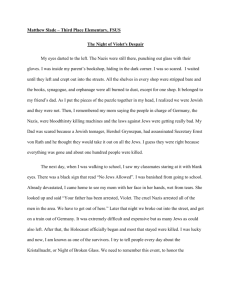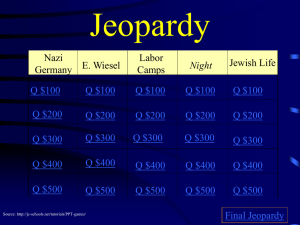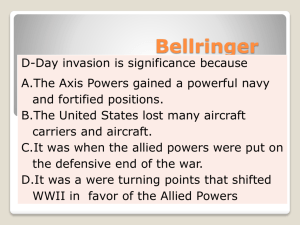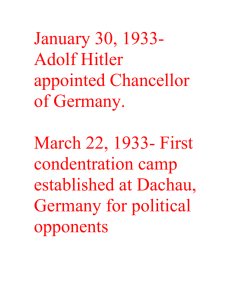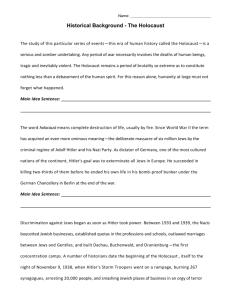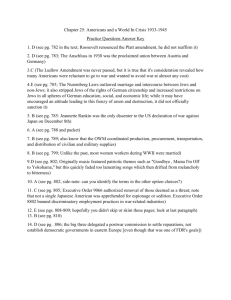TEACHER: CLASS: 5th Grade DATE: March 28 M T W TH F FRAME
advertisement
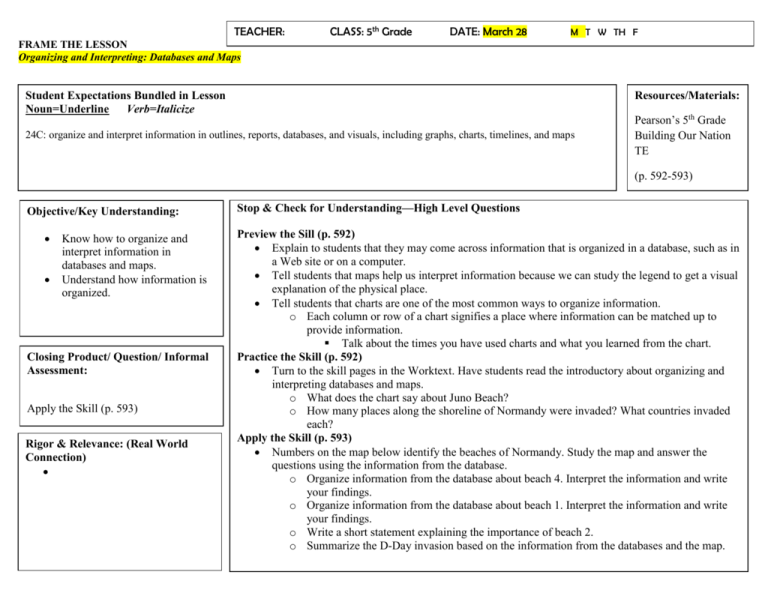
TEACHER: CLASS: 5th Grade DATE: March 28 M T W TH F FRAME THE LESSON Organizing and Interpreting: Databases and Maps Student Expectations Bundled in Lesson Noun=Underline Verb=Italicize Resources/Materials: 24C: organize and interpret information in outlines, reports, databases, and visuals, including graphs, charts, timelines, and maps Pearson’s 5th Grade Building Our Nation TE (p. 592-593) Objective/Key Understanding: Stop & Check for Understanding—High Level Questions Preview the Sill (p. 592) Explain to students that they may come across information that is organized in a database, such as in a Web site or on a computer. Tell students that maps help us interpret information because we can study the legend to get a visual explanation of the physical place. Tell students that charts are one of the most common ways to organize information. o Each column or row of a chart signifies a place where information can be matched up to provide information. Talk about the times you have used charts and what you learned from the chart. Closing Product/ Question/ Informal Practice the Skill (p. 592) Assessment: Turn to the skill pages in the Worktext. Have students read the introductory about organizing and interpreting databases and maps. o What does the chart say about Juno Beach? Vocabulary: Apply the Skill (p. 593) oVocabulary: How many places along the shoreline of Normandy were invaded? What countries invaded each? Apply the Skill (p. 593) Rigor & Relevance: (Real World Numbers on the map below identify the beaches of Normandy. Study the map and answer the Connection) questions using the information from the database. o Organize information from the database about beach 4. Interpret the information and write your findings. o Organize information from the database about beach 1. Interpret the information and write 5C your findings. o Write a short statement explaining the importance of beach 2. identify the accomplishments of individuals and groups such as Jane Addams, Susan B. Anthony, Dwight Eisenhower, Martin Luther o Summarize the D-Day invasion based on the information from the databases and the map. Know how to organize and interpret information in databases and maps. Understand how information is organized. King Jr., Rosa Parks, Cesar Chavez, Franklin D. Roosevelt, Ronald Reagan, Colin Powell, the Tuskegee Airmen, and the 442nd Regimental Combat Team who have made contributions to society in the areas of civil rights, women's rights, military actions, and politics Engage Explore Preview the Sill (p. 592) Explain to students that they may come across information that is organized in a database, such as in a Web site or on a computer. Tell students that maps help us interpret information because we can study the legend to get a visual explanation of the physical place. Tell students that charts are one of the most common ways to organize information. o Each column or row of a chart signifies a place where information can be matched up to provide information. Talk about the times you have used charts and what you learned from the chart. Analyzing Historical Visuals (p. 592) Build background knowledge on organizing and interpreting databases and maps. Use the following to differentiate instruction for students when they are discussing how to analyze documents and biographies. Special Needs: Have students locate the beaches of Normandy on a globe. Hold a class discussion regarding the relationship between the location of the five beaches and Allied casualties. Extra Support: Ask student to use the library and collect five samples of chart or other databases. On-Level: Invite students to write a paragraph to explain and interpret the information shown on the map on page 593. Challenge/Gifted: Ask students to use additional information to find out which beach in the chart matches which number on the map. Explain Elaborate Practice the Skill (p. 592) Turn to the skill pages in the Worktext. Have students read the introductory about organizing and interpreting databases and maps. o What does the chart say about Juno Beach? o How many places along the shoreline of Normandy were invaded? What countries invaded each? After students learn about organizing and interpreting through databases and maps, use the ELPS support note on page 584b to help the English Language Learners. Encourage students to work with peers to help them complete the Learn and Try It! Sections. Beginning As students work through the Try It! Questions, encourage them to give more details. Ask questions such as, “Where is Beach 4? Which troops landed there?” Intermediate To help students prepare to answer question 3, have them orally explain the importance of Beach 2. Encourage them to be specific and give more details when possible. Advanced As students use the map to explain the invasion, ask them to add more details, such as order of invasion, date, country of invasion, and movement from land controlled by Allied or Axis powers. Advanced High Have pairs of students work together to orally explain the map and add more detail to each other’s explanations. Evaluate Apply the Skill (p. 593) Have students work in groups to complete the Apply Activity. Alternatively, this activity can be assigned as homework. Numbers on the map below identify the beaches of Normandy. Study the map and answer the questions using the information from the database. o Organize information from the database about beach 4. Interpret the information and write your findings. o Organize information from the database about beach 1. Interpret the information and write your findings. o Write a short statement explaining the importance of Beach 2. o Summarize the D-Day invasion based on the information from the databases and the map. FRAME THE LESSON The Holocaust TEACHER: CLASS: 5th Grade DATE: March 29-30 M T W TH F Resources/Materials Student Expectations Bundled in Lesson Noun=Underline Verb=Italicize Pearson’s 5th Grade Building Our Nation TE 5A: analyze various issues and events of the 20th century such as industrialization, urbanization, increased use of oil and gas, the Great Depression, the world wars, the civil rights movement, and military actions (p. 594-599) Objective/Key Understanding: Closing Product/ Question/ Informal Assessment: 5C Analyze the Nazi practice of genocide. Summarize the Allied liberation of surviving Jews in Europe. Identify countries in which surviving Jews resettled after the war. identify the accomplishments of individuals and groups such as Jane Addams, Susan B. Anthony, Dwight Eisenhower, Martin Luther about the role ofD.Adolf HitlerRonald and theReagan, German policies that to the Holocaust. King Jr.,Draw Rosa conclusions Parks, Cesar Chavez, Franklin Roosevelt, Colin Powell, theled Tuskegee Airmen, and the 442nd Describe the Nazi use of Jewish ghettos, concentration camps, and death camps. Regimental Combat Team who have made contributions to society in the areas of civil rights, women's rights, military actions, and Explain attempts to resist the Nazi persecution of Jews. politics Got it Questions 1-6 (p. 594-599) 17D Vocabulary describe&the origins and(Real significance national celebrations such as Memorial Day, Independence Day, Labor Day, Constitution Day, Rigor Relevance: WorldofConnection) Columbus Day, and Veterans Day Concentration camp Anti-Semitism genocide ghetto Holocaust Stop and Check for Understanding- High Level Questions Genocide (p. 594) What do you think will happen when the Allies discover the people in the concentration camps? What did the Germans want to accomplish through their policy of genocide? How do you think the posting of such signs affected Jewish shop owner economically? German Anti-Semitism (p. 595) Why did the Nazis force Jews to wear yellow stars on their clothes? Why did the Nazis make Jews noncitizens? How did violence against the Jewish people escalate over the course of the war? Put the following events in the correct sequence: Jews were forced to wear yellow stars on their clothing; Jews were sent to concentration camps where they were starved, worked to death, beaten, and killed; Kristalnacht or the “Night of Broken Glass.” Concentration Camps (p. 596-597) Why did the Nazis most like think they had the right to treat Jewish people so badly? How were they wrong? To help students understand the progression of the Nazi rule Resisting the Nazi (p. 597) Why did the Jews in Warsaw stage a rebellion in April 1943? How was the Warsaw rebellion an example of what is worth fighting for? The Experience of Anne Frank (p. 597) How did non-Jewish people all over Europe resist the Nazis? What question might you ask Anne Frank? How do you think keeping a diary helped Anne Frank to deal with the experiences of living through World War II and having to live in hiding and in fear of being captured? Survival and Freedom (p. 598-599) How did the Nazis try to cover up evidence related to genocide as they retreated from Poland to Germany? Have students study the photo on page 598. How do you think the soldier in the background felt at the time the photograph was taken? In what order did the following events occur? The Germans retreated from Poland to Germany. Americans and other Allies liberated camps in Germany. The Jewish state of Israel was established. Have students look at the sculpture on page 599. What do you think the artist wanted to portray with this sculpture? Where did many Holocaust survivors go after the war? What question might you ask a Holocaust survivor who has lost his or her home? Why did so many Jews remain in concentration camps after liberation? What did the United States do to help the many displaced Jews find a new home? Engage Explore Explain Introduce Key Idea & Vocabulary (p. 594) Read to the class the Key Idea: “I will know that the Nazis killed millions of Jews and other people in the Holocaust.” Tell students in this lesson they will be learning about this quote and what it means to American History. Go online to access the Lesson Introduction and discuss the Big Question and lesson objective (p. 594). Students are to complete the Using the Words to Know Worksheet before reading the lesson. Remind students that they will know that the Nazis killed millions of Jews and other people in the Holocaust. Genocide (p. 594) German Anti-Semitism (p. 595) Concentration Camps (p. 596-597) Resisting the Nazi (p. 597) The Experience of Anne Frank (p. 597) Survival and Freedom (p. 598-599) Remind students that they will know that the Nazis killed millions of Jews and other people in the Holocaust. Genocide (p. 594) What the Allied soldiers first found shocked them. But they had not yet seen the worst. In several of the camps, they would find buildings designed just for killing people. They would uncover mass graves. German Anti-Semitism (p. 595) Hitler and his Nazis began to promote ant-Semitism, or hatred of Jews. They blamed Jews for all of Germany’s problems. They said Jews were inferior. They claimed that Germans were superior. They forced Jews to wear yellow star on their clothes, so they could be easily identified. Concentration Camps (p. 596-597) The Nazis began rounding up Jews and placing them in ghettos. Jewish ghettos had existed in European cities and towns for centuries. But under the Nazis they now had a special purpose. Jews were held I ghettos until they could be sent to concentration camps. Resisting the Nazi (p. 597) Life in the ghettos was very harsh. Disease and starvation were common. The Warsaw ghetto in Poland was the largest. About 450,000 people lived there. The Nazis built a 10-foot wall around it to keep people from escaping. The Experience of Anne Frank (p. 597) Anne Frank, a Jewish girl in the Netherlands, also resisted. When the Germans invaded, Anne and her family went into hiding in an office building of her father’s. for two years in hiding, Anne kept a diary. The diary shows that she remained hopeful. She wrote, “In spite of everything I still believe that people are really good at heart.” In 1944, the Nazis found the Franks. Anne ended up in a concentration camp, where she died of an illness at age 13. Survival and Freedom (p. 598-599) Millions of Jews died in the concentration camps. But some survived. They hoped and prayed that one day they would be free again. Elaborate Questions from the Stop and Check for Understanding- High Level Questions are to be used here. (Please see this from above). Students will demonstrate mastery by completing the Got It Questions: (below is a sampling of the questions a teacher can use to evaluate student Evaluate mastery). Analyze the photo on the right. Write what you think what might have happened. Identify a list of the emotions you see in this photograph. This is the Holocaust Memorial in Miami Beach, Florida. Explain why memorials to the Holocaust are important. Explain why the Nazis in Germany established a policy of anti-Semitism. You are a non-Jewish friend of Anne Frank. Identify one reason why you might help hide her from the Nazis. Identify one reason why you might not. Make an inference as to why you think other countries would not accept Jews who were trying to flee nazi Germany. FRAME THE LESSON World War II in the Pacific TEACHER: CLASS: 5th Grade DATE: March 31 M T W TH F Resources/Materials Student Expectations Bundled in Lesson Noun=Underline Verb=Italicize Pearson’s 5th Grade Building Our Nation TE 5A: analyze various issues and events of the 20th century such as industrialization, urbanization, increased use of oil and gas, the Great Depression, the world wars, the civil rights movement, and military actions (p. 600-607) Objective/Key Understanding: Closing Product/ Question/ Informal Assessment: Describe the Pacific as a second major battle front of World War II in which Allied forces fought against Japan. Identify key battles in the Pacific. Summarize U.S. military technologies and strategies in the Pacific. identify the accomplishments of individuals and groups such as Jane Addams, Susan B. Anthony, Dwight Eisenhower, Martin Luther Analyze the decisions of U.S. President Truman to use the atomic bomb against Japan. Airmen, and the 442nd King Jr., Rosa Parks, Cesar Chavez, Franklin D. Roosevelt, Ronald Reagan, Colin Powell, the Tuskegee Draw conclusions about themade global human and costs of of World War II.women's rights, military actions, and Regimental Combat Team who have contributions to economic society in the areas civil rights, Identify the changes to the borders of Germany and the Soviet Union at the end of the war. politics 5C 13E explain the impact of American ideas about progress and equality of opportunity on the economic development and growth of the United States Rigor & Relevance: (Real World Connection) A friend of yours cannot understand why the United States used the atomic bomb. Summarize why the atomic bomb was used. Vocabulary Island hopping atomic bomb Got it Questions 1-9 (p. 600-607) Stop and Check for Understanding- High Level Questions War in the Pacific (p. 600-601-579) How was warfare in the Pacific different from warfare in Europe? What Japanese city did Navy fliers target for their first air attack on Japan? How did General Douglas Mac Arthur’s view of the war differ from that of the Japanese admiral quoted on page 601? Why do you think long-range bombers would play a key role in the Pacific war? What was one effect of the American victory at the Battle of Midway? From Island to Island (p. 602-603) What place did Japan consider the big prize of the South Pacific? How would you summarize why the U.S. Marines were well suited for battles in the Pacific? What did the Japanese plan to accomplish by bombing Pearl Harbor? What do you think could have happened if the United States had not used island hopping to defeat the Japanese? Why do you think the Japanese fought more fiercely the closer Allied forces came to Japan? What effect did island hopping have on the Japanese? Why wasn’t island hopping a good strategy to use on the Philippines? How many Americans were lost during the Battle at Okinawa? What were the costs and benefits of these important battles with Japan? A Dangerous Weapon (p. 604) What does to engineer something mean? What do you think President Roosevelt thought when Albert Einstein hinted that the Germans might be making an extremely powerful bomb? What was the code name given to the secret work done to develop the atomic bomb? Hiroshima and Nagasaki (p. 604-605) Which event happened first, the bombing of Hiroshima, the bombing of Nagasaki, or the death of President Roosevelt? Why do you think the atomic bomb research was codenamed the Manhattan Project? Why were military officials hesitant to invade Japan? On what two cities was the atomic bomb used/ President Truman had to make a difficult decision regarding the war against Japan after Roosevelt’s death. What were his two main alternatives? Why was the date August 14, 1945, significant? Why did President Truman drop the second bomb? What effects do you think dropping the atomic bomb had on Japanese-United States relations? What were the costs President Truman had to consider when deciding whether or not to use the atomic bomb on Japanese cities? The Effects of the War (p. 606) Which four countries occupied Germany after World War II? Which nation had more war deaths than any other nation during World War II? Why is the economic cost of the war difficult to determine? What do you think will happen as a result of the Soviet Union keeping control of a section of Germany? Which nation had the fewest fatalities in the war? Why do you think the Soviet Union refused to release its control over part of Germany? Before the war, the United States and the Soviet Union did not have the best relationship. How do you think the Soviet Union’s remaining in part of Germany affected that relationship? What challenges do you think the United States had to deal with in regard to the new weaponry? A New Role (p. 607) Why could the United States no longer return to isolationism after the war? After reading the last paragraph of page 607, what question would you like to have answered about an action taken by the United States? Engage Explore Explain Elaborate Evaluate Introduce the Key Idea & Vocabulary (p. 600) Read to the class the Key Idea: “I will know that the Allies won the war in the Pacific.” Tell students in this lesson they will be learning about this quote and what it means to American History. Go online to access the Lesson Introduction and discuss the Big Question and lesson objective (p. 600). Students are to complete the Using the Words to Know Worksheet before reading the lesson. Remind students will know that the Allies won the war in the Pacific. War in the Pacific (p. 600-601-579) From Island to Island (p. 602-603) A Dangerous New Weapon (p. 604) Hiroshima and Nagasaki (p. 604-605) The Effects of the War (p. 606) A New Role (p. 607) Remind students will know that the Allies won the war in the Pacific. War in the Pacific (p. 600-601-579) Warfare in the Pacific was different from warfare in Europe. Unlike in Europe, the war in the Pacific was fought mostly by naval forces. Japan was a nation of several islands. It controlled land from China, south through Southeast Asia. Much of Japan’s growth was the result of its taking over other islands in the Pacific Ocean. The aircraft carrier would be at the center of many of the battles. The long-range bomber, too, would play a key role in the Pacific theatre of the war. From Island to Island (p. 602-603) In late 1942, Japanese leaders still dreamed of enlarging their empire. They wanted to claim the big prize of the South Pacific: Australia. But the island of Guadalcanal helped to end that dream. The fight with the Allies for that island lasted more than five months. After losing much of their navy there, the Japanese retreated in February 1943. A Dangerous New Weapon (p. 604) While American troops fought in Europe and the Pacific, a different kind of challenge was taking shape at home. Scientists were trying to create the first atomic bomb. Their secret work was given the code name the Manhattan Project. Hiroshima and Nagasaki (p. 604-605) President Roosevelt died in April 1945. Now it was up to the new President, Harry S. Truman, to make a hard choice. He had to decide whether to drop an atomic bomb on Japan. The Effects of the War (p. 606) The human cost of World War II was terribly high. As many as 60 million people may have died as a result of the fighting. Although the exact number is hardtop estimate, half probably died serving in the armed forces. The other half were civilians, or people not in the military. A New Role (p. 607) By the end of the war, the United States had proven itself to be an important world leader. It could no longer return to its prewar isolationism. Questions from the Stop and Check for Understanding- High Level Questions are to be used here. (Please see this from above). Students will demonstrate mastery by completing the Got It Questions: (below is a sampling of the questions a teacher can use to evaluate student mastery). Navies and aircraft clashed at the Battle of Midway in the Pacific. Write a caption that explains why this battle was a turning point. Identify and underline sentences in the text that describe why it was hard for American troops to capture a Pacific Island. Identify which happened first, the Battle of Iwo Jima or the Battle of Midway. Explain why deciding to use the atomic bomb was a difficult decision to make. Complete the Venn diagram to compare and contrast the fighting tactics, or methods, during World War II in Europe and the Pacific. Analyze this map. Which country benefited the most from changes to national boundaries as a result of World War II? Explain why the Allies developed the Pacific strategy of island hopping. A friend of yours cannot understand why the United States used the atomic bomb. Summarize why the atomic bomb was used. Describe how World War II helped to make the United States into a new world power. FRAME THE LESSON TEKS Assessment and Practice TEACHER: CLASS: 5th Grade DATE: April 1 M T W TH F Student Expectations Bundled in Lesson Noun=Underline Resources/Materials Verb=Italicize 5A: analyze various issues and events of the 20th century such as industrialization, urbanization, increased use of oil and gas, the Great Depression, the world wars, the civil rights movement, and military actions U.S. History Textbook Colonization through Reconstruction pp. 608-611 5C: Identify the accomplishments of individuals and groups such as Jane Addams, Susan B. Anthony, Dwight Eisenhower, Martin Luther King Jr., Rosa Parks, Cesar Chavez, Franklin D. Roosevelt, Ronald Regan, Colin Powell, the Tuskegee Airmen, and the 442nd Regimental Combat Team who have made contributions to society in the areas of civil rights, women’s rights, military actions, and politics. Objective/Key Understanding: : ~ After studying this topic, students will demonstrate the following enduring understandings: The United States’ alliances with European nations obliged it to help defend those countries from German expansion. The United States was drawn into war in the Pacific to defend itself following the attack on Pearl Harbor. Without the help and sacrifices of the American military, Allied forces may not have won World War II. As a result of ant-Semitism, millions of Jews and other people were murdered by the Nazis during World War II. ~Students will answer questions about every TEKS on the TEKS Practice pages 608-611.
